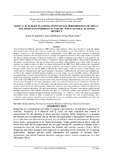| dc.description.abstract | Several Small and Medium Enterprises (SMEs) fail to make budgets; others do it but fail to constantly update
their budgets and evaluate their progress against the actual budgets, or are disgruntled by the futility of the
budgets prepared, or the budgeting process. Subsequently, most SMEs pay more attention to financial
performance measures but disregard the more strategic non-financial indicators. This study sought to establish
the effect of budget planning on financial performance of SMEs in Nakuru town C.B.D. It was guided by the
Agency Theory, Balanced Scorecard Theory, Contingency Theory and Stakeholders’ Theory and it adopted the
descriptive research design. The unit of observation was SMEs within Nakuru town C.B.D. while the unit of
analysis was business owners or officer in-charge of finance in the SME. Each SME produced one respondent
who was either the owner or officer in-charge of finance. According to Nakuru East Sub-County Business
Register (2018), there are 26,158 SMEs in Nakuru East Sub-County; 7,456 are located within Nakuru town
C.B.D. and are classified into eight major categories. Nassiuma’s (2000) formula was used to get a sample size
of 108. It also adopted stratified random sampling to get the sample size of each SME category. The formula
was appropriate to ensure equal probability of selecting each unit from the population being studied. The study
further used purposive sampling to select the biggest SMEs in each category. This was informed by the fact that
some of the small SMEs have no structures and rarely prepare budgets. Questionnaires were used to collect the
primary data desirable for the study. Quantitative data was analyzed through the aid of Statistical Package for
Social Sciences (SPSS) version 22. Descriptive and inferential statistics were used in data analysis. Descriptive
statistics involved the use of percentages, frequencies, measures of central tendencies (mean) and measures of
dispersion (standard deviation). The inferential statistics employed were Pearson’s correlation coefficient and
multiple regressions. The findings revealed that there is a moderate positive and statistically significant
correlation between budget planning and financial performance. (r = 0.443; p < 0.05). The study recommended
that budget review should be done as frequently as possible to increase the level of understanding. Also,
evaluating major projects should be given priority for it increases reliability and accountability and makes the
employees more knowledgeable on budget planning practices | en_US |

